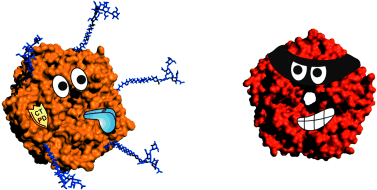Binding at five sites: effective cholera inhibitor based on cholera toxins

(Phys.org) —Cholera against cholera: a novel inhibitor prevents the cholera toxin from binding to carbohydrates found on the surface of intestinal cells. An international team of researchers has described their elegant concept in the journal Angewandte Chemie: The protein scaffold of the inhibitor is based on an inactive cholera toxin. It is equipped with five sugar moieties to act as ligands. The inhibitor's size and number of binding sites are both perfectly matched to the cholera toxin bearing five binding sites.
Cholera is a bacterial infectious disease that is primarily transmitted through insufficiently treated drinking water and contaminated foods. The actual pathogen is a toxin released by the bacteria; it attacks the cells of the intestine and causes life-threatening diarrhea.
Cholera toxin is a protein consisting of a toxic A unit and five nontoxic B units (CTB). Its shape resembles a blossom with five petals. The "petals" are nontoxic, but they bind to special carbohydrates—the oligosaccharide units on glycolipid GM1—on the surface of intestinal cells, initiating uptake of the toxin. Each of the five B subunits possesses a specific binding site for the special sugar motif.
In order to put a stop to the pentavalent cholera toxin, scientist at the University of Leeds (UK), Wageningen University (Netherlands), and King Abdulaziz University in Jeddah (Saudi Arabia) have now developed a pentavalent inhibitor. To make it properly fit with its counterpart they fell back on the old principle of "fighting fire with fire": They used an inactive version of the five "petals" from CTB subunits as the protein scaffold for their inhibitor.
Led by Bruce Turnbull, the researchers induced a mutation in the GM1 binding site of the CTB subunits so that the inhibitor does not bind to the intestinal cells. In addition, a special side chain on each of the "petals" was chemically altered so that they could undergo a coupling reaction by which five ligands were then attached with flexible spacers. The ligands were chosen to be the ideal binding partners for the toxin: the saccharide units from glycolipid GM1. The advantage of this method is that the inhibitor presents the toxin with five ligands that are in exactly the same distance apart as the five binding sites of the toxin, making it the perfect counterpart. The potency of the new pentavalent inhibitor for its target molecule is thus correspondingly high.
Although the synthesis of the sugar motif is relatively complicated, the protein scaffold can easily be produced genetically on an industrial scale, and can easily be chemically modified and the saccharides attached. The researchers hope that this synthetic technique can be used to develop further multivalent inhibitors for other protein–carbohydrate interactions.
More information: A Protein-Based Pentavalent Inhibitor of the Cholera Toxin B-Subunit, Angewandte Chemie International Edition, Permalink to the article: dx.doi.org/10.1002/anie.201404397
Journal information: Angewandte Chemie , Angewandte Chemie International Edition
Provided by Wiley


















